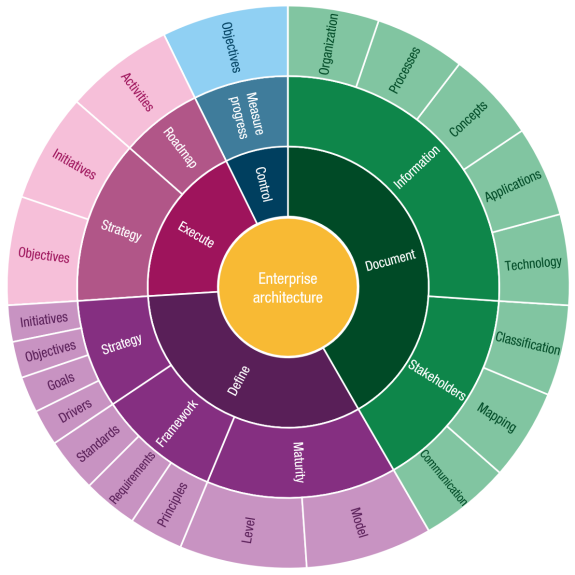The Enterprise Architecture Implementation Wheel is a practical and pragmatic approach to developing and implementing a fundamental Enterprise Architecture.
The method is visualized by means of a wheel. It is built around a central circle, called Enterprise Architecture.
The image below is interactive. Click on the various slices (parts) to learn more about that specific part.

Enterprise Architecture Implementation Wheel
The Wheel distinguishes four main stages. Each stage consists of one or more steps. Each step in turn consists of a number of key focus areas. The four stages and the associated steps are based on and inspired by the TOGAF® Standard. They can therefore be mapped to the phases of the Architecture Development Method (ADM).
Going through the four stages will help develop a solid and fundamental Enterprise Architecture. However, this does not mean that each stage and its steps must be followed to the letter. The method should be seen primarily as a source of inspiration.
More information about the Implementation Wheel can be found in my book Getting Started with Enterprise Architecture.
The four stages
Stage one: Document, is the first stage of the Enterprise Architecture Implementation Wheel.
The stage consists of the following steps:
Read more about Stage one: Document.
- About the methodThe Enterprise Architecture Implementation Wheel is based on the TOGAF® Standard. The method adapts TOGAF's structure and flow by reorganizing it into four main stages: Document, Define, Execute, and Control. Each stage is broken down into one or more steps, each of which includes key focus areas and actionable artifacts. This offers organizations a streamlined entry point.
Rather than aiming for exhaustive coverage, the Enterprise Architecture Implementation Wheel provides a scalable foundation that organizations can build upon as they mature. It establishes a solid basis for effectively adopting and applying the core principles of the TOGAF Standard. - How to read the wheelThe first ring around the center is the ring that defines the four main stages of the Implementation Wheel. Each stage consists of one or more steps.
The steps form the second ring around the center circle and provide valuable information on how to approach each stage. The steps also define a number of key focus areas that are relevant to these steps.
The key focus areas are presented in the third and final ring around the center circle. Each of the key focus areas details the various architectural deliverables that can be created to complete the previously mentioned steps.
The Implementation Wheel should preferably be read clockwise, from the inside out. However, the method also supports an iterative approach. This allows for a starting point of choice.
